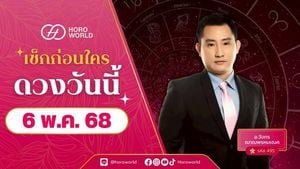Netflix's film Los Dos Hemisferios de Lucca has quickly become the streaming giant's latest hit, capturing viewers' hearts with its compelling true story. This poignant tale centers around the life of Lucca Bianciotto Anderson, born with cerebral palsy due to complications during birth. His mother, Bárbara Anderson, alongside her husband, Andrés, embarked on an extraordinary quest for treatment, seeking solutions where medical professionals had cast doubt.
After debuting at the top of Netflix's charts, Los Dos Hemisferios de Lucca stands out not just for its storytelling, but for the authenticity behind it—rooted deeply in the real-life experiences of the Anderson family. The film's gripping narrative is based on Bárbara's autobiographical book of the same name, published prior to the film's release.
Born on October 14, 2011, Lucca's birth was filled with promise, but the moment quickly turned tragic. During delivery, he suffered from oxygen deprivation leading to irreversible brain damage, resulting in severe cerebral palsy and frequent epileptic seizures. This harrowing diagnosis initially left the family devastated as doctors warned them Lucca might never walk or speak.
Despite the grim prognosis, Bárbara and Andrés refused to succumb to despair. They committed themselves to researching potential treatments around the globe. "We traveled to India seeking hope, and we found it there," expressed Andrés during promotional interviews. They discovered the Cytotron, an experimental device employing magnetic resonance to aid neural regeneration. This discovery became their beacon of hope.
Following their extensive research, the couple and their son traveled to India, where they underwent the groundbreaking treatment. The film showcases their emotional and challenging experiences, highlighting the complex family dynamics balanced against the backdrop of medical chaos. The treatment process lasted 28 days, promising revitalization through sessions with the Cytotron. Lucca's progress was astonishing; he began to take his first steps, moments previously deemed impossible.
Starring Bárbara Mori as Bárbara Anderson and Juan Pablo Medina as Andrés, along with eleven-year-old Julián Tello bring Lucca's character to life, the film employs touching performances to illuminate the family’s ordeal. The young actor, Tello, captivates the audience not only with his acting but also through his own inspirational story of triumph against cerebral palsy. Chosen from over 200 other children for the part, Tello’s real-life experiences parallel Lucca’s character, offering authenticity to the portrayal.
Director and the crew ensured every detail was captured authentically, filming on locations throughout Mexico and India. For ten days, they shot scenes across Bhopal and Bangalore, reflecting the geographical and emotional journeys of the family.
Beyond its narrative of personal struggle, Los Dos Hemisferios de Lucca speaks to universal themes of resilience, the unbreakable bond between mother and child, and the importance of community support for families facing disabilities. Critics have lauded the film not simply for its emotional weight but for prioritizing inclusion and advocacy for the disabled. Bárbara Anderson states, "The experiences of families with disabled children are often overlooked, and our aim is to shed light on their struggles." Such sentiments resonate deeply with viewers, encouraging discussions on societal perception and the challenges faced by special needs communities.
Configurably, the film not only entertains but educates, challenging viewer perceptions around disability, and encouraging empathy and action within society.
Since its release on January 31, 2025, Los Dos Hemisferios de Lucca has made waves, inspiring countless viewers with its unwavering message of hope. The story invites reflection on the lengths parents go to for their children’s well-being and the transformative power of love and perseverance—elements intricately interwoven within the film.
With its heartwarming and realistic portrayal of parental love, this film is sure to remain influential, potentially shifting audiences’ views on disabilities and families’ rights to fight for the future of their children.



